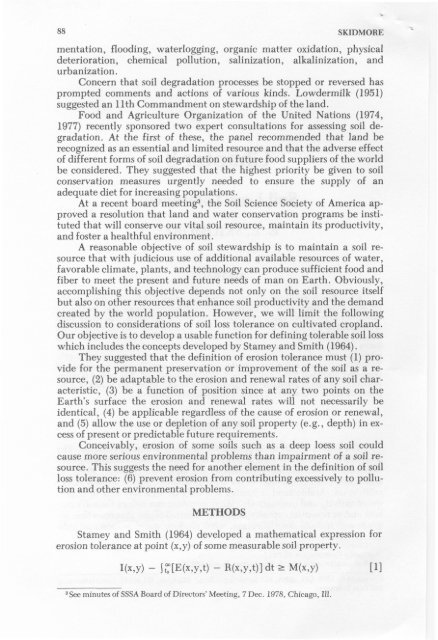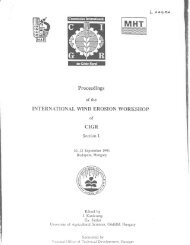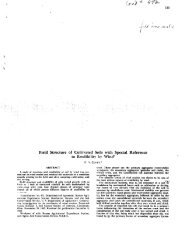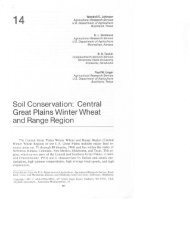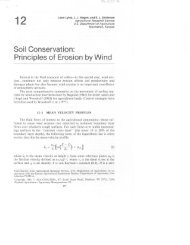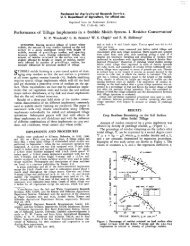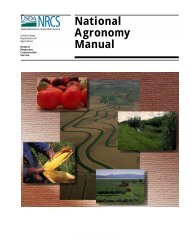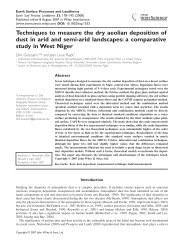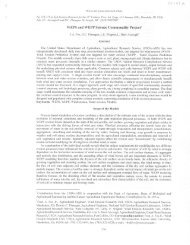Soil Loss Tolerance - USDA-ARS Wind Erosion Research Unit
Soil Loss Tolerance - USDA-ARS Wind Erosion Research Unit
Soil Loss Tolerance - USDA-ARS Wind Erosion Research Unit
Create successful ePaper yourself
Turn your PDF publications into a flip-book with our unique Google optimized e-Paper software.
88 SKIDMORE<br />
mentation, flooding, waterlogging, organic matter oxidation, physical<br />
deterioration, chemical pollution, salinization, alkalinization, and<br />
urbanization.<br />
Concern that soil degradation processes be stopped or reversed has<br />
prompted comments and actions of various kinds. Lowdermilk (1951)<br />
suggested an 11th Commandment on stewardship of the land.<br />
Food and Agriculture Organization of the <strong>Unit</strong>ed Nations (1974,<br />
1977) recently sponsored two expert consultations for assessing soil degradation.<br />
At the first of these, the panel recommended that land be<br />
recognized as an essential and limited resource and that the adverse effect<br />
of different forms of soil degradation on future food suppliers of the world<br />
be considered. They suggested that the highest priority be given to soil<br />
conservation measures urgently needed to ensure the supply of an<br />
adequate diet for increasing populations.<br />
At a recent board meeting, the <strong>Soil</strong> Science Society of America approved<br />
a resolution that land and water conservation programs be instituted<br />
that will conserve our vital soil resource, maintain its productivity,<br />
and foster a healthful environment.<br />
A reasonable objective of soil stewardship is to maintain a soil resource<br />
that with judicious use of additional available resources of water,<br />
favorable climate, plants, and technology can produce sufficient food and<br />
fiber to meet the present and future needs of man on Earth. Obviously,<br />
accomplishing this objective depends not only on the soil resource itself<br />
but also on other resources that enhance soil productivity and the demand<br />
created by the world population. However, we will limit the following<br />
discussion to considerations of soil loss tolerance on cultivated cropland.<br />
Our objective is to develop a usable function for defining tolerable soil loss<br />
which includes the concepts developed by Stamey and Smith (1964).<br />
They suggested that the definition of erosion tolerance must (1) provide<br />
for the permanent preservation or improvement of the soil as a resource,<br />
(2) be adaptable to the erosion and renewal rates of any soil characteristic,<br />
(3) be a function of position since at any two points on the<br />
Earth's surface the erosion and renewal rates will not necessarily be<br />
identical, (4) be applicable regardless of the cause of erosion or renewal,<br />
and (5) allow the use or depletion of any soil property (e.g., depth) in excess<br />
of present or predictable future requirements.<br />
Conceivably, erosion of some soils such as a deep loess soil could<br />
cause more serious environmental problems than impairment of a soil resource.<br />
This suggests the need for another element in the definition of soil<br />
loss tolerance: (6) prevent erosion from contributing excessively to pollution<br />
and other environmental problems.<br />
METHODS<br />
Stamey and Smith (1964) developed a mathematical expression for<br />
erosion tolerance at point (x, y) of some measurable soil property.<br />
I(x,Y) - S,"[E(x,y,t) - R(x,y,t)l dt 2 M(X,Y) [I1<br />
See minutes of SSSA Board of Directors' Meeting, 7 Dec. 1978, Chicago, Ill.


